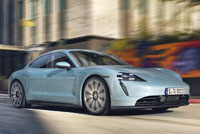
Porsche revealed two final production Taycan EVs last month, but without doubt some potential buyers found the Turbo and Turbo S models’ respective $173,900 and $213,900 price tags a bit too rich for their budgets. Of course, the Stuttgart, Germany-based performance brand promised more affordable versions to follow, and therefore the $119,400 Taycan 4S is upon us. Priced much closer to the $108,990 base Tesla Model S, this is the EV “volume” model Porsche needs.
So what does the $55k (or $95k) buy you? Performance. Wheels aside there’s no obvious difference to exterior or interior design, or materials quality for that matter, but in place of the Taycan Turbo’s 671 horsepower, 627 lb-ft of torque, and launch control-assisted 3.2-second run to 100 km/h sprint from standstill to 100 km/h, or the Turbo S model’s even more outrageous 750 horsepower, 774 lb-ft of torque, and 2.8-second second run to 100 km/h, the new 4S uses makes due with “just” 522 horsepower, 472 lb-ft of torque and a 4.0-second dash to the 100-km/h mark.
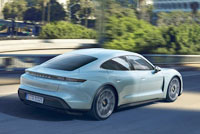
A Performance Battery Plus package is available, boosting output to 562 horsepower and torque to 479 lb-ft for a nominal difference in naught to 100 km/h sprints (although Porsche rates it at 4.0 seconds as well), yet this upgraded Taycan 4S’ shoots from standstill to 160 km/h in a scant 8.5 seconds instead of dawdling along at just 8.7 seconds. Both 4S power units limit the Taycan’s terminal velocity to 250 km/h, which incidentally is 30 km/h less speedy than the Turbo or Turbo S.
Under the Taycan 4S floorboards are 79.2 kilowatt-hours of high-voltage lithium-ion battery capable of 407 km (253 miles) of estimated range, as per the European WLTP rating system, while the enhanced 93.4-kWh Performance Plus battery provides about 463 km (288 miles) of range. This compares well with next to the Taycan Turbo’s 388 to 412 km (241 to 256 mile) claimed range and the Turbo S’ 388 to 412 km (241 to 256 mile) estimates.
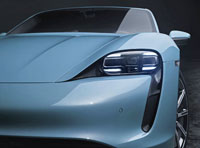
No matter the trim, the Taycan uses an industry-first 800-volt electrical architecture that makes for faster recharging due to a charge-rate of 225 kW with the Performance Battery or 270 kW for the upgraded Performance Battery Plus, making 22.5-minute 5-to-80-percent refills possible with all power unit specs. Regular 400-volt high-speed DC recharging happens at 50 kW, but an available booster can increase the charge-rate to 150 kW. You can also use the standard AC charge system at any J1772-compatible charging station, or plug it in at in at home, but charging times will be considerably longer.
Topping the Taycan up is made easier via Porsche’s new Charging Planner, which allows you to plot your route by mapping out ideal charging stations along the way. For instance, it will choose a quicker 270-kW station that can save you time when compared to a regular 50-kW DC charger, even if the quicker charger necessitates a detour from the shortest route. The Charging Planner also preconditions the battery to 20 degrees Celsius, which is best for the fastest possible charge-rate.
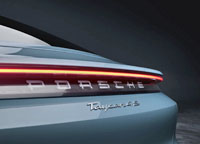
Like the Taycan Turbo and Turbo S, the new 4S incorporates an all-wheel drivetrain featuring front and back axle-mounted permanently excited synchronous motors plus a two-speed transmission in the rear. Additionally, Porsche’s centrally networked 4D Chassis Control system provides real-time analysis and synchronization for the Taycan’s standard electronic damper control Porsche Active Suspension Management (PASM) enhanced three-chamber adaptive air suspension, which should result in impressive road-holding capability.
What’s more, Taycan customers should enjoy improvements in reliability over Tesla Model S owners, thanks to Porsche designing a completely new hairpin winding technique for the electric motor stators’ copper solenoid coils, this allowing for a copper fill factor of 70 percent compared to 45 percent when wound using the conventional method, all of which results in stronger performance and less heat.
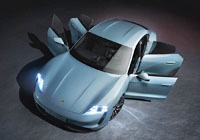
Monitoring the Taycan’s mobility status is a wholly digital primary gauge cluster filled with colourful high-resolution graphics and integrated within a free-standing, curved binnacle that pulls styling cues from the brand’s legendary 911. Just to the right, the Taycan 4S’ standard 10.9-inch high-definition capacitive infotainment touchscreen sits atop the centre stack. Most will also want the optional front passenger display that was introduced last month with the Taycan Turbo and Turbo S, this innovative addition extending the graphical experience across the rest of the instrument panel.
Features in mind, the Taycan 4S receives standard Black or White exterior paint, a unique front fascia design, a glossy black painted rear diffuser and side skirts, LED headlamps with Porsche Dynamic Light System Plus (PDLS Plus), 19-inch five-spoke Taycan S Aero alloys, red-painted six-piston front and four-piston rear brake calipers (instead of the yellow-painted calipers found on the two Turbo models) biting down on 360-mm front and 358-mm rear discs, regenerative brakes (with a maximum regenerative force of 0.39 Gs and recuperation of up to 265 kWh), proximity keyless entry, ambient interior lighting, partial leather upholstery, eight-way power-adjustable front seats with driver’s side memory and more, but take note this base model won’t go into production until June, 2020. Before then, the $1,690 panoramic glass sunroof replaces the standard aluminum roof, while the optional Porsche Mobile Charger Plus isn’t available yet either, which leaves the standard Porsche Mobile Charger Connect system for early adapters.
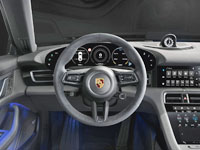
Available Taycan 4S options include a bevy of $910 metallic exterior colours, including the Taycan’s Frozen Blue launch colour shown in the photos, plus bright Mamba Green and deep Gentian Blue, as well as one $3,590 special colour, Carmine Red. Additionally, Porsche is offering two sets of optional 20-inch alloys and three 21-inch wheels, all ranging from $2,710 to $10,010, while the car’s black partial leather cabin can be upgraded to $4,710 black or multiple $5,360 two-tone leather, $7,490 solid or $8,150 two-tone Club leather, or alternatively $4,710 solid or $5,360 two-tone leather-free Race-Tex, the latter Porsche-first incorporating recycled materials that reduce the Taycan’s impact on the environmental.
The new Porsche should be near silent at speed too, due to an amazing Cd of 0.22, plus this ultra-aerodynamic design also minimizes energy use.
Porschephiles wanting a taller SUV model instead of this road-hugging four-door coupe will be glad to know that a crossover coupe dubbed Cross Turismo is on the way next year. It’s designed to go up against the Jaguar I-Pace, Tesla Model X and whatever else comes down the pike by then, so we can all look forward to that.
You can order the new 2020 Taycan 4S right now, however, just like its Turbo siblings, while its arrival date is set for summer 2020.
Story credits: Trevor Hofmann
Photo credits: Porsche
